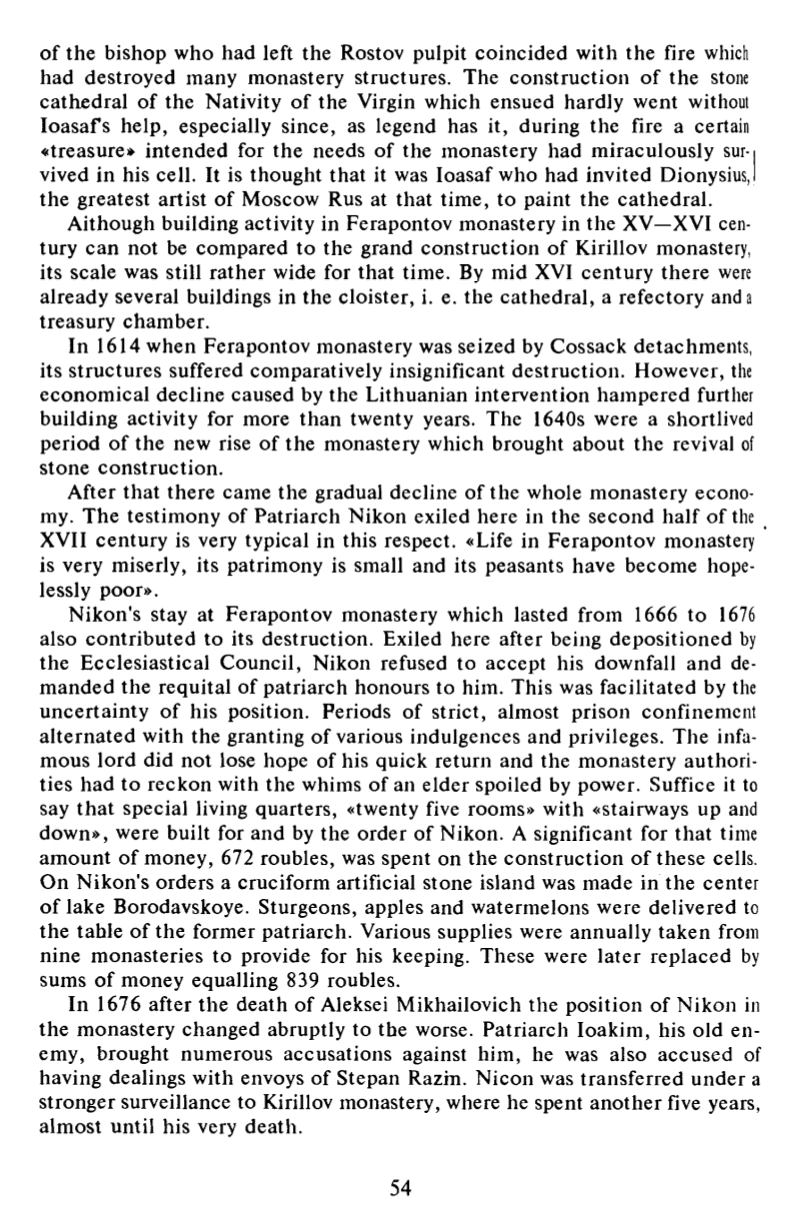

o f the bishop who had left the Rostov pulpit coincided with the fire which
had destroyed many monastery structures. The construction o f the stone
cathedral of the Nativity o f the Virgin which ensued hardly went without
Ioasa fs help, especially since, as legend has it, during the fire a certain
«treasure» intended for the needs of the monastery had miraculously sur-i
vived in his cell. It is thought that it was Ioasaf who had invited Dionysius,!
the greatest artist o f Moscow Rus at that time, to paint the cathedral.
Aithough building activity in Ferapontov monastery in the XV—XVI cen
tury can not be compared to the grand construction o f Kirillov monastery,
its scale was still rather wide for that time. By mid XVI century there were
already several buildings in the cloister, i. e. the cathedral, a refectory and a
treasury chamber.
In 1614 when Ferapontov monastery was seized by Cossack detachments,
its structures suffered comparatively insignificant destruction. However, the
economical decline caused by the Lithuanian intervention hampered further
building activity for more than twenty years. The 1640s were a shortlived
period o f the new rise o f the monastery which brought about the revival of
stone construction.
After that there came the gradual decline of the whole monastery econo
my. The testimony of Patriarch Nikon exiled here in the second half o f the
XVII century is very typical in this respect. «Life in Ferapontov monastery
is very miserly, its patrimony is small and its peasants have become hope
lessly poor».
Nikon's stay at Ferapontov monastery which lasted from 1666 to 1676
also con tribu ted to its destruction. Exiled here after being depositioned by
the Ecclesiastical Council, Nikon refused to accept his downfall and de
manded the requital of patriarch honours to him. This was facilitated by the
unce rtain ty o f his position. Periods of strict, almost prison confinement
a lte rna ted with the granting of various indulgences and privileges. The infa
mous lord did no t lose hope of his quick return and the monastery authori
ties had to reckon with the whims of an elder spoiled by power. Suffice it to
say th a t special living quarters, «twenty five rooms» with «stairways up and
down», were built for and by the order of Nikon. A significant for that time
amoun t o f money, 672 roubles, was spent on the construction o f these cells.
On Nikon's orders a cruciform artificial stone island was made in the center
o f lake Borodavskoye. Sturgeons, apples and watermelons were delivered to
the tahle o f the former patriarch. Various supplies were annually taken from
nine monasteries to provide for his keeping. These were later replaced by
sums o f money equalling 839 roubles.
In 1676 after the death of Aleksei Mikhailovich the position of Nikon in
the monastery changed abruptly to the worse. Patriarch Ioakim, his old en
emy, brought numerous accusations against him, he was also accused of
having dealings with envoys of Stepan Razm. Nicon was transferred under a
stronger surveillance to Kirillov monastery, where he spent ano ther five years,
almost until his very death.
54















